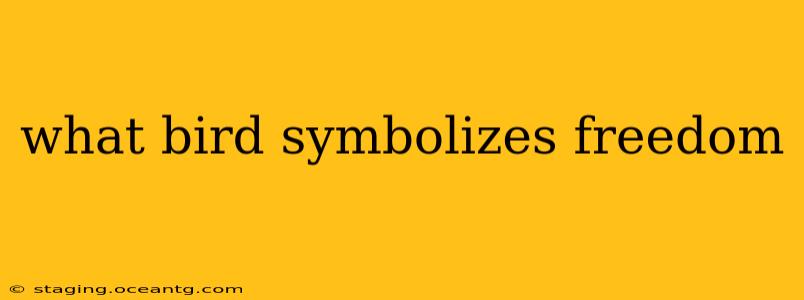The majestic eagle, soaring high above the earth, is undoubtedly the most widely recognized bird symbol of freedom. But why is it so strongly associated with this concept, and are there other birds that also embody this powerful idea? Let's explore the rich symbolism behind various avian creatures and their connection to freedom.
Why is the Eagle a Symbol of Freedom?
The eagle's association with freedom stems from several key characteristics:
- Its powerful flight: Eagles possess exceptional strength and agility in the air, effortlessly navigating vast distances and soaring to incredible heights. This visual representation of unconstrained movement naturally lends itself to the idea of liberation.
- Independence and self-reliance: Eagles are apex predators, fiercely independent and reliant on their own skills for survival. They are not easily intimidated and represent a spirit of self-determination, perfectly mirroring the ideal of freedom.
- Historical and cultural significance: Across numerous cultures, including the United States, the eagle has held a prominent place in mythology and national symbolism. Its inclusion on national emblems and seals reinforces its association with freedom and national pride. For example, the Bald Eagle features prominently on the Great Seal of the United States, solidifying its status as a symbol of American freedom and independence.
What Other Birds Symbolize Freedom?
While the eagle holds a dominant position, several other birds also carry strong symbolic weight related to freedom:
- The Albatross: Often depicted in literature and art as representing a solitary existence and the vastness of the open ocean, the albatross embodies a sense of unbound exploration and independence. Its long, powerful wingspans evoke a sense of limitless freedom.
- The Swallow: Known for their swift and graceful flight, swallows often symbolize hope, spring, and renewal. Their migratory patterns, traveling thousands of miles between continents, suggest a spirit of adventure and freedom from constraints.
- The Dove: While frequently associated with peace, the dove can also symbolize freedom, especially in the context of escaping confinement or oppression. Its ability to fly freely represents the hope for liberation and a new beginning.
- The Phoenix: Though not strictly a bird found in nature, the mythical Phoenix rising from the ashes represents rebirth and freedom from the constraints of the past. This immortal creature embodies the triumph over adversity and the achievement of freedom.
What Makes a Bird a Symbol of Freedom?
Ultimately, the association of birds with freedom comes down to their inherent ability to fly. Flight itself represents an escape from the terrestrial constraints of the world, a liberation from the ground. However, the specific bird chosen often reflects deeper cultural and historical significance, adding layers of meaning to the symbol.
What are the Different Meanings of Birds in Different Cultures?
The meaning of a bird's symbolism can vary considerably depending on cultural context. For instance, some cultures might associate a particular bird with spirituality or good luck, whereas others might view the same bird with different interpretations. The rich diversity of cultures around the world has shaped the varied meanings attributed to birds, highlighting the complex relationship between humans and the natural world.
How are Birds Used as Symbols in Art and Literature?
Birds frequently appear in art and literature as powerful symbols, often representing freedom, hope, or spiritual transcendence. Artists and writers leverage the visual and metaphorical potential of birds to enhance their narratives and communicate deeper themes.
Conclusion
The eagle is indeed a powerful and iconic symbol of freedom, but it's not alone. Many birds, each with its unique characteristics and cultural significance, evoke feelings of liberation, independence, and the boundless possibilities that freedom represents. The enduring power of avian symbolism reminds us of the profound connection between humanity and the natural world.
